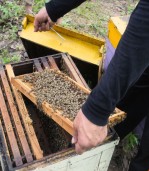เก็บรักษาน้ำผึ้งให้หอมหวาน?
วิธีเก็บรักษาน้ำผึ้งให้หอมหวานได้นานปี
น้ำผึ้งเป็นผลิตภัณฑ์จากธรรมชาติที่มีประโยชน์มากมาย ไม่ว่าจะเป็นการใช้ในอาหาร การบำรุงสุขภาพ หรือการดูแลผิวพรรณ น้ำผึ้งยังเป็นที่นิยมในการใช้เพื่อเพิ่มรสชาติหวานและกลิ่นหอมเฉพาะตัวให้กับอาหารและเครื่องดื่มต่างๆ อย่างไรก็ตาม หลายคนอาจไม่ทราบว่าน้ำผึ้งมีวิธีการเก็บรักษาอย่างไรให้คงคุณค่าทางอาหารและความหอมหวานไว้ได้นานปี หากเก็บรักษาไม่ถูกวิธี น้ำผึ้งอาจสูญเสียรสชาติหรือคุณสมบัติบางอย่างไป ดังนั้นบทความนี้จะมาแนะนำวิธีการเก็บรักษาน้ำผึ้งให้หอมหวานคงทนและสามารถใช้งานได้อย่างยาวนาน
ทำไมการเก็บรักษาน้ำผึ้งจึงสำคัญ?
น้ำผึ้งเป็นสารที่มีคุณสมบัติต้านเชื้อแบคทีเรียและเชื้อราตามธรรมชาติ ด้วยปริมาณน้ำตาลสูงที่มีอยู่ในน้ำผึ้ง จะทำให้น้ำผึ้งมีความเข้มข้นพอที่จะยับยั้งการเติบโตของแบคทีเรียและเชื้อราได้ อย่างไรก็ตาม การเก็บรักษาน้ำผึ้งอย่างถูกต้องยังคงเป็นเรื่องสำคัญ เพราะการเก็บรักษาที่ไม่ถูกวิธีอาจทำให้น้ำผึ้งเกิดการตกตะกอน เสื่อมสภาพ หรือสูญเสียรสชาติและกลิ่นหอมอันเป็นเอกลักษณ์ไป
1. เก็บรักษาในภาชนะที่ปิดสนิท
การเก็บรักษาน้ำผึ้งในภาชนะที่ปิดสนิทเป็นวิธีที่สำคัญที่สุด เนื่องจากน้ำผึ้งมีคุณสมบัติที่ดูดความชื้นจากอากาศได้ง่าย หากปล่อยให้น้ำผึ้งสัมผัสกับอากาศเป็นเวลานาน อาจทำให้ความชื้นจากอากาศซึมเข้าไปในน้ำผึ้ง ส่งผลให้น้ำผึ้งมีโอกาสเกิดการหมักหรือเสื่อมสภาพได้ นอกจากนี้ การเก็บในภาชนะที่ปิดสนิทยังช่วยป้องกันการปนเปื้อนจากสิ่งสกปรกและแมลงต่างๆ ที่อาจเข้ามาในน้ำผึ้งได้อีกด้วย
2. เลือกใช้ภาชนะที่เหมาะสม
ภาชนะที่ใช้เก็บน้ำผึ้งควรเลือกใช้วัสดุที่ไม่ทำปฏิกิริยากับน้ำผึ้ง เช่น แก้วหรือพลาสติกที่ปลอดภัยต่ออาหาร หลีกเลี่ยงการใช้ภาชนะโลหะ เนื่องจากน้ำผึ้งมีความเป็นกรดเล็กน้อย ซึ่งอาจทำปฏิกิริยากับโลหะได้ ทำให้เกิดการเปลี่ยนแปลงของรสชาติหรืออาจทำให้โลหะซึมเข้ามาในน้ำผึ้ง นอกจากนี้ ภาชนะควรมีฝาปิดที่ปิดสนิทและสามารถกันอากาศได้ดี
3. เก็บในที่แห้งและเย็น
สถานที่ที่เหมาะสมสำหรับการเก็บน้ำผึ้งคือที่แห้งและเย็น หลีกเลี่ยงการเก็บน้ำผึ้งในที่ที่มีอุณหภูมิสูงหรือโดนแสงแดดโดยตรง อุณหภูมิที่เหมาะสมในการเก็บน้ำผึ้งคือประมาณ 10-20 องศาเซลเซียส การเก็บน้ำผึ้งในที่ที่ร้อนเกินไปอาจทำให้น้ำผึ้งเสื่อมสภาพเร็วขึ้น หรือเกิดการตกตะกอนเป็นผลึกได้ ส่วนการเก็บในตู้เย็นก็ไม่แนะนำเช่นกัน เนื่องจากอุณหภูมิต่ำเกินไปอาจทำให้น้ำผึ้งตกผลึกเร็วขึ้น
4. ระวังการเก็บรักษาในระยะยาว
แม้ว่าน้ำผึ้งจะมีอายุการเก็บรักษาที่ยาวนาน แต่การเก็บในระยะยาวก็ต้องใส่ใจเป็นพิเศษ การเก็บรักษาน้ำผึ้งในระยะยาวควรเลือกภาชนะที่ทนทานและปิดสนิท เพื่อป้องกันการสูญเสียความชื้นและป้องกันสิ่งปนเปื้อน นอกจากนี้ การตรวจสอบน้ำผึ้งอย่างสม่ำเสมอเพื่อดูว่ามีการตกตะกอนหรือไม่ก็เป็นเรื่องที่ควรทำ ถ้าพบว่าน้ำผึ้งตกตะกอนหรือมีรสชาติเปลี่ยนแปลง ควรทำการละลายน้ำผึ้งในน้ำอุ่นเพื่อคืนสภาพ
5. การละลายน้ำผึ้งที่ตกผลึก
หากน้ำผึ้งเกิดการตกผลึกจนกลายเป็นก้อนแข็ง ไม่ต้องกังวล เพราะสามารถละลายน้ำผึ้งให้กลับมาเป็นของเหลวได้ง่ายๆ ด้วยการอุ่นน้ำผึ้งในอ่างน้ำอุ่น ห้ามใช้อุณหภูมิที่สูงเกินไป เพราะความร้อนสูงอาจทำลายคุณค่าทางอาหารในน้ำผึ้งได้ โดยวิธีที่เหมาะสมคือการแช่ภาชนะน้ำผึ้งในอ่างน้ำที่อุ่นพอประมาณ และค่อยๆ คนจนกว่าน้ำผึ้งจะกลับมาเป็นของเหลว
6. การใช้ช้อนหรืออุปกรณ์ในการตักน้ำผึ้ง
เมื่อต้องการใช้น้ำผึ้ง ควรใช้ช้อนหรืออุปกรณ์ที่สะอาดและแห้งในการตักน้ำผึ้ง หลีกเลี่ยงการใช้อุปกรณ์ที่เปียกหรือไม่สะอาด เพราะอาจทำให้ความชื้นและสิ่งสกปรกปนเปื้อนในน้ำผึ้งได้ การดูแลความสะอาดของอุปกรณ์ในการตักน้ำผึ้งจึงเป็นเรื่องสำคัญที่จะช่วยรักษาคุณภาพของน้ำผึ้งให้คงอยู่ได้นาน
7. การป้องกันการเกิดฟองอากาศในน้ำผึ้ง
บางครั้งน้ำผึ้งที่เก็บรักษาไว้อาจเกิดฟองอากาศขึ้น ซึ่งอาจเกิดจากการที่น้ำผึ้งสัมผัสกับอากาศ หรือเกิดจากการเคลื่อนไหวภายในภาชนะที่เก็บไว้ ฟองอากาศอาจทำให้น้ำผึ้งเกิดการเสื่อมสภาพหรือทำให้รสชาติเปลี่ยนแปลงได้ วิธีป้องกันการเกิดฟองอากาศคือการเก็บน้ำผึ้งในภาชนะที่ปิดสนิทและหลีกเลี่ยงการเขย่าหรือเคลื่อนย้ายภาชนะบ่อยๆ
สรุป
การเก็บรักษาน้ำผึ้งให้หอมหวานและคงคุณค่าได้นานปีเป็นเรื่องที่ต้องใส่ใจในรายละเอียด ตั้งแต่การเลือกภาชนะที่เหมาะสม การเก็บรักษาในที่แห้งและเย็น ไปจนถึงการใช้อุปกรณ์ที่สะอาดในการตักน้ำผึ้ง หากคุณดูแลน้ำผึ้งของคุณอย่างถูกวิธี น้ำผึ้งจะคงความหอมหวานและคุณประโยชน์ไว้ได้นานปี และพร้อมที่จะนำมาใช้ในอาหารหรือการบำรุงสุขภาพตามต้องการ
อ่านเพิ่มเติม >>





 Copyright : Engine by CW 2025 www.ibeemade.com
Copyright : Engine by CW 2025 www.ibeemade.com